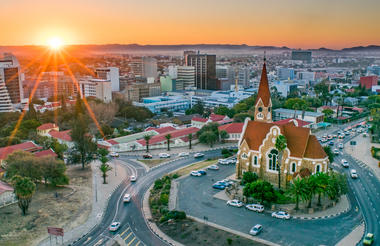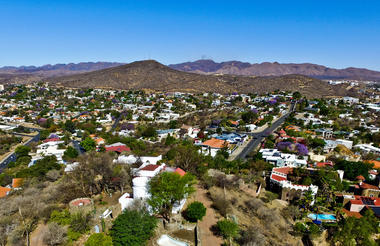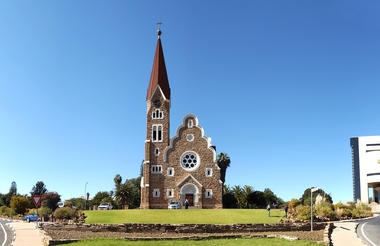There is something mesmerizingly thrilling about exploring Namibia. Wind-swept desert dunes, polished white plains and abundant wildlife create an alluring atmosphere throughout the land. Namibia boasts remarkable natural attractions such as the Namib Desert, the Skeleton Coast and the Fish River Canyon. The wildlife offerings are second to none, and the country holds an average of 300 sunny days per year, making it an ideal destination all year round. Its diverse landscapes offer reliable game viewings regardless of the season and is undoubtedly one of the most exciting and rewarding experiences. The country inhabits more than 20 species of antelope, along with the famous Big 5 and many other magnificent creatures - some found nowhere else in the world. The country is often referred to as "one big desert" and described as a place where nature governs the land. With Namibia being one of the least populated nation on earth, it really is one of the best spots to spend a social distancing holiday.
Greater Windhoek can be described as a tourists paradise. The things to be seen and done in and around the capital city of Namibia are endless. The hot springs of Gross Barmen are found just north of Windhoek. The springs have a natural temperature of 65 °C but are cooled down in order for people to enjoy them. Another attraction in close vicinity to Windhoek is the Daan Viljoen game park. Being a conservation area for many game species, it boasts large numbers of wildlife. With its diverse range of natural and cultural attractions, visiting the region in and around the city is an incredible experience.



Solitaire is located at the edge of the Namib-Naukluft National Park, a short distance from the dunes of Sossusvlei and Walvis Bay. This remote settlement has served as a welcome stopover for over 60 years. On arrival, the first thing to catch your attention is the number of car wrecks that have been picturesquely displayed along the road. The region's grasslands can be explored via hiking trails in rocky foothills. Visitors can also take scenic drives and ride hot air balloons. Solitaire is committed to protecting both the grassland ecosystem and the wildlife that inhabit the area.

Nestled on the west coast of the Namib Desert - where the dunes meet the ocean - is the popular little town of Swakopmund. This laid-back area offers charm in bucket loads with its colonial architecture, quaint restaurants and historic landmarks - such as the "Mole" sunset pier. The cobbled streets and picturesque buildings indicate the rich heritage and culture this town holds, while the museums show its diverse history. This area radiates personality - from the more relaxed daytime charm to the vibrant atmosphere of the night - this is one of Namibia's hidden gems that need to be experienced.
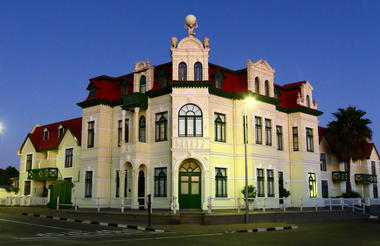
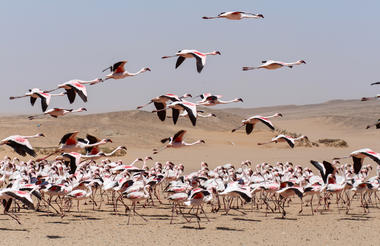
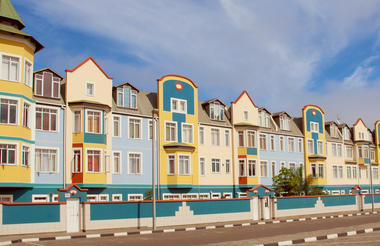
Very few natural landscapes match up to the spectacular views of Spitzkoppe. The peaks stand out dramatically against the flat, desolate scenery below, making it one of Namibia's must-see attractions. Here, the famous Rock Arch can be found - a photographer's dream. Climbing the Spitzkoppe is no easy task. However, if conquered, the views from above are unlike any other! Spend sunrise and sunset sitting tranquilly in nature's beauty, watching the rocks' colours change from bright reds to light yellows, granting endless opportunities to relish in the contrasting light and shadowy patterns of the cliffs.
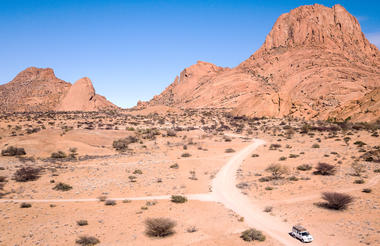
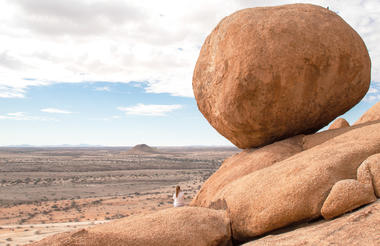
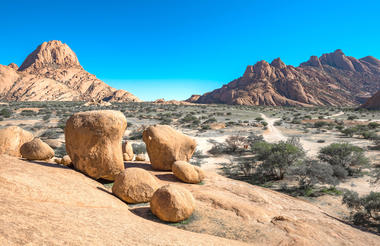
Rarely do you find a location as alluring and powerful as the haunting Skeleton Coast. The vast and contrasting land ranges from towering dunes to clay hills dotted along the riverbeds. This treacherous coast - marked by rocky and sandy beaches, rusting shipwrecks and soaring dunes is home to the scarce desert-adapted elephants, which are among the most incredible creatures on earth. Running hundreds of kilometres, the Skeleton Coast entices visitors to come and discover the wonders that this scenic safari offers. The white sands and arid landscape is a truly unforgettable experience from start to finish.
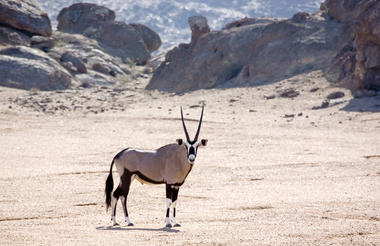
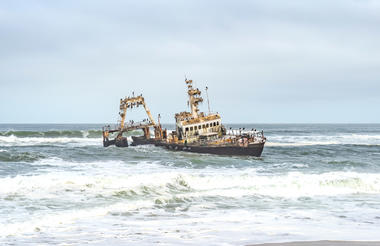
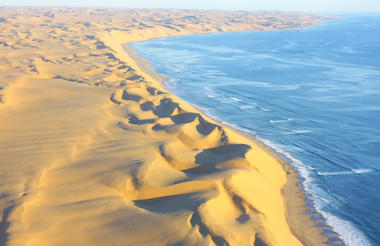
Twyfelfontein is a site of ancient rock engravings in the semi-arid region of north-western Namibia. This world heritage site is situated 100 kilometres from the ocean, where the scenery shifts from dry red sands to lush grassland. Drawn by the San People, the engravings show depictions of both human and animal tracks. Many of the impressions also depict animals that are no longer found in the area - including lion, zebra, kudu and even seals! Visiting these paintings, with their rich historical and cultural backgrounds, allows you to learn about the Namibian heritage and the San people's customs and beliefs.
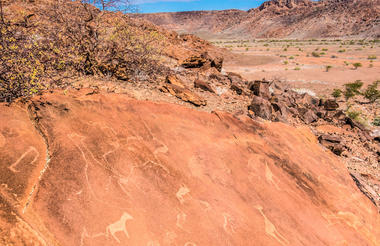
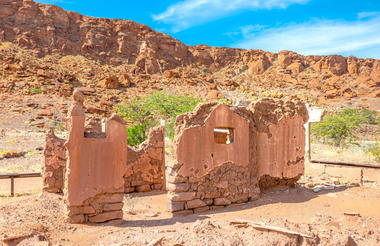

Situated on the eastern side of Etosha, bordering Fisher's Pan, Onguma Game Reserve is one of In the eastern parts of the Etosha National Park, bordering Fishers Pan lies the Onguma Private Game Reserve. Protecting more than 34,000 acres of land, this private reserve is home to over thirty species of animals, from kudu, giraffe and oryx, to predators such as lion, cheetah and leopard. The Onguma water hole is also a great place to spot game. Game drives, guided walks, and rhino research drives can be enjoyed within the reserved area, and safaris into Etosha National Park are available to see the abundance of animals. Here you will have the opportunity of experiencing Africa in all her beauty and diversity.



With its striking copper and red sandstone cliffs, Waterberg Plateau is one of Namibia's most magnificent natural wonders. Surrounded by freshwater springs, the brick-red peaks rise up out of the surrounding Namibian savannah, overlooking the Kalahari Desert. Dinosaur footprints, mysterious rock engravings and a thriving number of Black and White Rhino scatter the plains. Natural canyons of the plateau feature open grasslands and lush woodlands. With vivid landscapes and an indescribable atmosphere, Waterberg is a must-do when visiting the country. The sheer beauty of the plateau is an unforgettable experience.
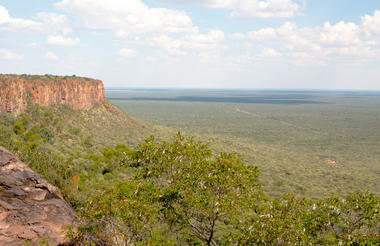
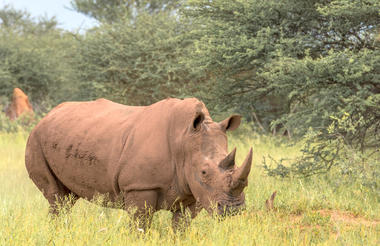

The capital Windhoek (translated as “windy corner”) is the political, cultural, industrial and economic center of Namibia with 400,000 inhabitants. Windhoek was founded on October 18, 1890, when the foundation stone for what is now known as the “Alte Feste” fortress was laid. Other popular sites include the Tintenpalast, the Christuskirche, the Kaisergymnasium and the Heinitz und Sanderburg. The quiet and well-organized city with a colonial German touch, offers German restaurants and shops, a widespread use of the German language, the celebration of German customs (such as Carnival or Oktoberfest) - the German tradition is reflected everywhere. Even the beer is still brewed according to the German "Reinheitsgebot" (special purity law). Mixed with African traditions and roots, Windhoek offers a unique atmosphere and a relaxed lifestyle that makes the city so endearing.
